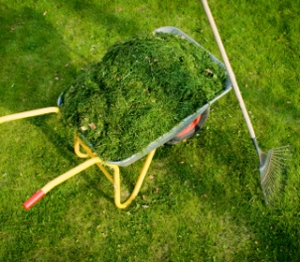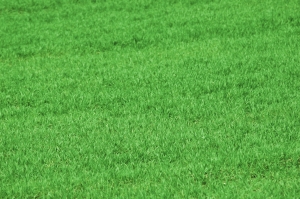Grass lawns are another one of those things we just take for granted. Everyone has them, so why should we do differently? Turns out, there’s very few reasons to use grass as a lawn.
Grasses are great at feeding grazing animals. This was their primary cultivated use throughout history. Afterwards, they became more of an ornamental feature in 16th century gardens because of their uniformity – bitches loved uniformity in the 16th century. Fast forward to today and we haven’t changed anything. Don’t get me wrong, there’s nothing wrong with an ornamental lawn; but at least choose a plant that’ll serve its purpose well. Unless you keep grazing animals beside your pool, your lawn is almost completely useless and in some cases harmful.
So without further ado, here are 6 reasons why grass lawns suck and a great alternative that actually makes sense.
1. They Need Constant Trimming
If you want a lawn that remains a short length, why on earth would you continue to use a plant that grows several feet high. This makes no sense. You need to cut it every week or so using a lawn mower. This is laborious and contributes to noise and air pollution.
At Valhalla, we use white clover as our all purpose lawn plant. It stays under a foot so we never have to cut it.

2. It Destroys Your Soil

Grass in itself doesn’t deplete your soil, but the way we treat it does. It’s a pretty intensive plant and as such requires a lot of soil nutrients and water. At the end of its life cycle it’s supposed to fall back to the ground and eventually degrade back into the soil, serving its purpose and keeping the soil rich. Unfortunately, we end up cutting the grass and throwing it away along with all the nutrients it took from the ground.
Clover not only doesn’t deplete your soil, since you don’t throw it away, it enriches it by turning nitrogen in the air into a usable form for plants in the earth. Nitrogen is one of those soil nutrients that help grow big and healthy plants. So merely by growing clover you can fertilize your lawn.
Which brings me to my next point:
3. Grass Lawns Usually Need Fertilizing
Most people need to fertilize their lawns to keep it looking healthy. Many use synthetic fertilizers that cost more money, kill your soil’s microbial life, and pollute water. ‘Nuff said.
4. They Also Require Frequent Watering
Grass requires a lot of watering to stay healthy. This once again adds to the labour required for upkeep.
Clover, on the other hand, has deeper tap roots that can access more water and is therefore more drought tolerant. It’ll stay green during a hot dry summer long after your grass has turned a dusty yellow. It’ll also survive further into the winter than grass. Also, unlike short grass, a clover lawn will provide a nice canopy for surface water so it won’t evaporate as fast.
5. Grass Doesn’t Get Along With Other Plants
Grass grows very tightly together which is why it’s great for high foot traffic or playing fields. It also spreads fast and well. So if you need a soccer field, this is your choice. But that’s not what we’re talking about when we think of a lawn. A lawn doesn’t get that much aggressive traffic. In fact, like we’ve established, it’s more of an ornamental feature that’s often paired with a garden. So why would we use grass, a plant that acts like a weed and chokes out and kills other plants we’re trying to grow? It’s a horrible choice for most situations.
Unlike grass which leads to soil compaction, clover has a root system that actually aerates the ground and allows other plants to grow. Its roots go deeper than most other plants and flowers and so it won’t compete with them for space or nutrients. Clover will actually help your other plants grow due to its nitrogen fixing qualities. In a clover lawn, you can easily dig a hole with your hands, drop a flower in it, and be confident that it’ll grow well.
In most yards there are a few well trafficked paths that clover may not stand up to too well. In this case, I suggest ground oregano. Much like grass, it grows very tightly and stands up to a pounding. However, it doesn’t spread as easily as grass and can therefore be trained into nice fragrant paths that release a faint sent of oregano every time you walk on it. It also feels amazing to walk on. If you find the oregano can’t stand the foot traffic either, just make wood chip or other types of paths. Defining and making paths is something you should be doing anyway. Your entire lawn is not a path and doesn’t get walked on everywhere.
6. Grass Lawns Are Ugly

This may be a matter of personal taste, but a bland uniform lawn that looks the same as 99% of your neighbours’ isn’t particularly attractive. It also discourages plant diversity and gardens. Where are the accent colours? Where’s the personality?
Once again clover reigns supreme in its ability to encourage an awesome and unique looking lawn tapestry. It has a deep green colour, darker than most grass and puts out a decent looking white or red flower spotted throughout its even growth. These flowers also attract bees which adds to the personality of your yard and helps pollination. You can easily plant other flowers and plant life to create your own yard masterpiece which requires little effort to make and maintain.

I will try it next summer to see the difference. I will do just the side of the house where the trail or is and compare with the other side where the garden is.
Awesome!
Here in central Texas they use “Buffalo grass,” which naturally grows short and requires less water. I’m not sure how much better it is than “normal” grass but at least it’s an attempt to make a difference. I’ve also heard of using honeysuckle as a ground-cover, which I bet would smell amazing.
Good point, there are different types of grass that’ll perform better.
Honey suckle would be cool! I use german chamomile to line paths but it can also grow as a ground cover. It smells delicious when you walk on it.
I have been experimenting with white clover as a green mulch and have been pleased. I too have dreamed of replacing the grass with it.
Have you thought much about dandelions or cumin in the mix. Dandelions also have a rather deep root which, in my theory, would draw up nutrients from the bedrock. They have a nice footprint which should help when initially transitioning from grass. In addition, they have hundreds of uses from culinary to medicinal to wine-making.
Cumin is a little taller, although I have seen some advertised as staying under 6 inches. Not sure if that is a specific variety or what. Maybe less suitable for foot traffic though.
I also have been interested in purslane. Very shallow roots, but extremely drought resistant little succulent. Good as a salad green, they are the most concentrated vegetable source of omega-3 fatty acids.
Will the clover take over, other weeds in the lawn?? I am trying to get rid of my bermuda grass and replace it with other ground cover, but in the process I have acquired many other weeds.
I find they don’t really take over other weeds, they just kind of grow in between pretty passively. Where they do help is stopping new weeds from forming from the start. If your lawn is completely covered in clover, other opportunistic weeds (pioneers) don’t have much of a chance to settle in. I recommend mulching directly over your weeds to kill them and then immediately planting the top with your new cover.
Where I’m from, we get a lot of dandelions – so they’re considered weeds. However, they really do no harm at all while offering so much. They’re a great companion to clover.
Our house was empty for several years before we purchased it two years back. I spent the first year watching the yard and scoping out anything pretty or interesting and identifying it, generating more specimens, and pushing back the grass. The side yard aka the found garden gifted us three kinds of moss, succulents, Pionies ( this had been mowed over for years and I let it grow back, the neighbor said she had tried to rescue it and is happy to see it thriving again) forget me nots, milk weed (for the butterflies), foxglove, Violets, clover and a few others I haven’t identified yet. I have also bummed around town and found a few people who leave clippings and new growth out for people to trade for, donate for, or just have. Nickle and dimes are all we have to put into the garden but we have seen it triple in size in just two full summers. Scored some free bricks a few days ago and cheap mulch to line a path in an area prone to flooding. Gardening has helped me integrate my creativity into everyday life and to interact with my local community in a way we might not be able to otherwise. Every year we make a new friend because of the garden. Apples get delivered to us and in turn we tap our Maple trees and give out the syrup. Now the neighbors to one side and across the street have offered to have us tap their trees next year. I am thrilled we have such a friendly community and people are interested to see the garden grow. Someday I hope to have a stand in the front yard for surplus crops bought by donation so local people, especially hungry people can come and have fresh sustainable food to eat.